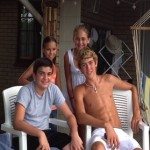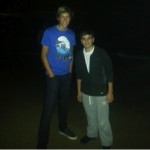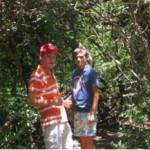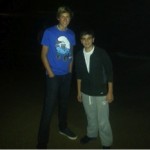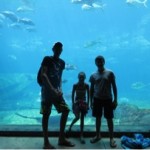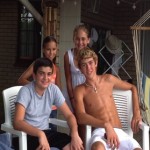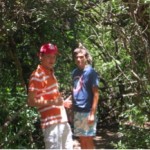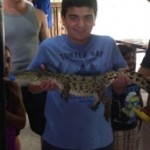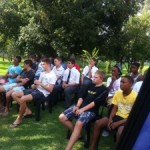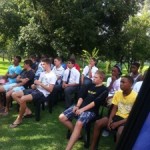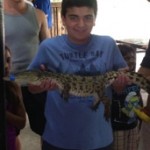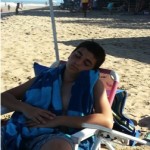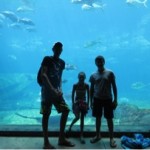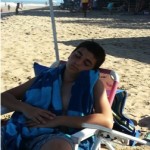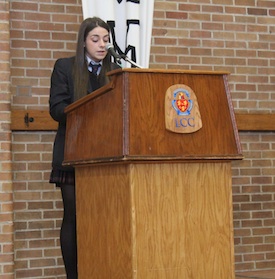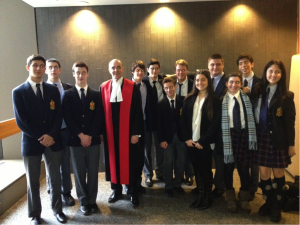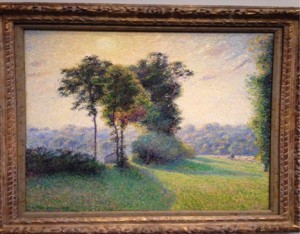I am delighted to report that after two weeks in South Africa, I have accumulated remarkable vocabulary—at least a dozen words in Afrikaans, which rivals the vocabulary painstakingly learned during six years of Hebrew day school! I now know how to say dankie (thank you), baie (very), and lekker (a nice Dutch word which means nice). It is a word used verryyyyyy often. It is used to describe a beautiful place, food that tastes good, and anything enjoyable. For example, “My time in South Africa has been very lekker. Very lekker indeed.”
January 2, 2013
I arrived in South Africa after a 20-hour trip. I am not sure what I expected. I had dimly thought that, since I was arriving from sunny Florida and not from buried-under-metres-of-snow Montreal, I would not be disoriented. I was wrong. I right away noticed that the country- lush, green, HOT- was very different from any place I’d ever been before.
My host family, Hannelie, Dirk, Jessica and Rickus Van Biljon picked me up in Durban. I knew right away that the difference in height between Rickus and I would be an endless source of amusement for my family and friends. In spite of that, Rickus and I instantly got (and still get) along exceptionally well. The whole family was welcoming, warm, just lekker. It’s a funny thing, that. You travel half way across the world, farther than Timbuktu even, and you find that people are just people.
I spent the next few days getting acclimatized and spent the balance of my winter holiday in one of the most beautiful countries in the world. The Van Biljon’s summer beach house is just 30 km from Durban, in Zinkwazi beach. I went to the beach the very first day, swimming in an ocean at once refreshing and warm, lazily talking with Rickus. I enjoyed myself very much, especially when I paused to think about home and what I would have been doing in Montreal. Napping at the beach is the best way to get over jet lag. During that first day, I met the Van Biljon’s family friends, Gustav, Sanelle, and their children Emma and five-year-old Duncan. They say that you can know a person by the company that he keeps. Well, Gustav, Sanelle, Emma and Duncan are extremely nice, which confirmed my opinion that the Van Biljon are great people.
The next few days—still my vacation—were just as “taxing” as the first. We took long walks on the beach, swam at least three times a day, debated the relative merits of American football and South African rugby. Rickus and I are both fluent in sports talk. I was introduced to cricket when the family watched the South African-New Zealand game. I must have been in hockey withdrawal, because I totally enjoyed that.
January 5, 2013
We went to Crocodile Creek, where the welcoming sign “ Nice to eat you” has been thoughtfully corrected to read “ nice to meet you,” no doubt to soothe the tender sensibilities of tourists like me. The crocodile farm was la lot of fun (and instructive too). When our tour guide wanted to introduce us to a crocodile that was hiding in the water, he would tap the crocodile in the face until the crocodile would try to bite him and in effect leap out of the water. South African crocodile tour guides are a different breed. I was able to hold a newly hatched crocodile, and a four-year-old crocodile. It was a little scary, but pretty cool too. The bottom of crocodiles is unbelievably soft, which, as the guide thoughtfully pointed out, explains why people want shoes, handbags, and belts made of alligator skin. We then went to check out the snakes, a definite highlight for me. Snakes are just soooooooo cool. My favourites were the black and green mambas. The inside of their mouths is black, and when they attack, it is truly scary. When they move, a full third of their body is off the ground. Just the stuff nightmares are made of. Another favourite is the vine snake, the most poisonous snake in South Africa. The vine snake is so good at camouflage that it took me a full five minutes to spot it. I had a fantastic time, but then I thought of all the times that I visited zoos in Montreal. I’d always think, “ thank goodness those snakes and animals are not indigenous to Montreal. Thank goodness they live in far away places like South Africa.” Of course, my very next thought was “Um. But right now, I’m in South Africa”… Like I said, just the stuff nightmares are made of.
I am so comfortable here, so happy, that I am always a little surprised when I realize that there are endless differences, some subtle, some not so subtle between South Africa and Canada. This is the coolest thing about this trip, the way I at once feel adventurous, disoriented, foreign and comfortable and familiar. It sounds like an oxymoron, but it is not. It is just great. But definitely, not every cultural reference that we take for granted in Montreal is a reference here. Les Miserables is not a classic here, but is simply a very new movie, and To Kill A Mockingbird is unknown. Robert Munsch does not exist here. Imagine that! As for me, well, I cannot tell you all the things I don’t understand. I very smoothly try to pass my ignorance for jet lag.
Right after the crocodile farm, we went to see The Life of Pi (very, very good). Just when I think that there are too many cultural differences between our two countries, I see something that reminds me that there are plenty of universal interests, like any Hollywood movie.
I also saw a movie called Spud, which is also a story about a kid going to a boarding school in SA
On one of our last days on the coast, we went to Ushaka Marine Land and Water Park in Durban. That was extremely fun. The aquarium was a vast shipwreck, very original. The fish were fantastic. We went to see a seal show, which was good, and a dolphin show, which was really VERY cool. The dolphins threw balls, and even played basketball under water. Very impressive. I heard that from the Van Biljon’s deck in Zinkwazi, you could catch dolphins swimming. There are things like that, which make me so happy to have chosen South Africa for my exchange.
January 9, 2013
Back in Jo’burg. I met Rickus’ friends from St. Stithians, explored the neighbourhood, and went on a hiking trail in the botanical gardens around the estate. I had a really amazing time on the hike. The scenery on the hike was amazing. I went with Rickus and on of his friends Kyle who is also extremely nice and with whom I get along very well.
January 14
Going to pre-tea at St. Stithians before the first full day of school starts. Definitely an adventure. Tomorrow, I’ll be sleeping at the Mount Stephens boarding house, and Wednesday, I’ll actually start school. It is all a little surreal, very exciting, and a little daunting. I’ll keep you posted.—David Elbaz ’15


